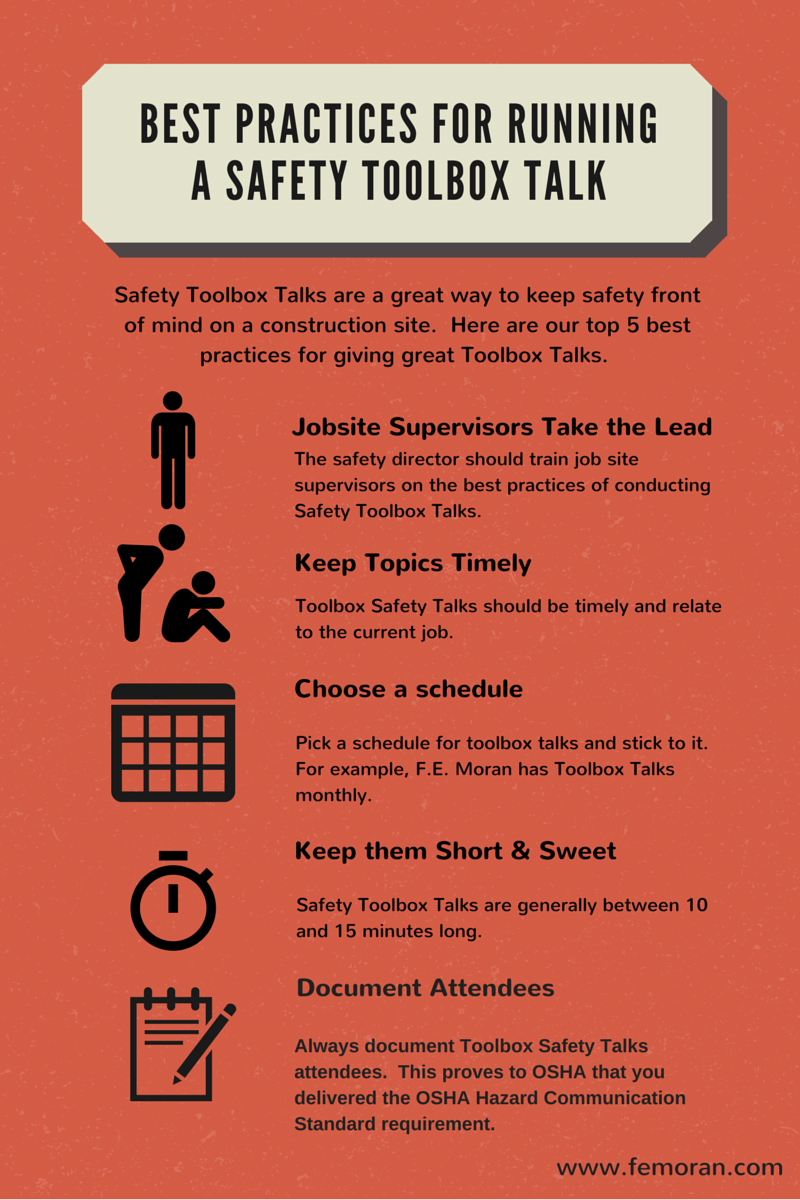In most aspects of construction, communication and training is absolutely key to running a successful project and business. That is especially true when it comes to safety on the job site. One of the most popular ways of communicating safety hazards to the field staff is through tool box talks.
Toolbox talks are typically relatively short discussions on specific subjects to keep construction workers aware of job site hazards. Making these a regular occurrence is a great way to instill a safety culture into your own employees and your subcontractors. There are many different ways to lead a toolbox talk, but some are much more effective and efficient than others.
To help focus your upcoming talks, FE Moran, a mechanical services and fire protection company based in Illinois, has put together an infographic of Best Practices for Running a Safety Tool Box Talk, which you can check out below.
FE Moran breaks down their best practices into five categories: make the jobsite supervisors take the lead, keep topics timely, choose a schedule, keep them short and sweet, and document attendees.
Jobsite Supervisors Take the Lead
Having the jobsite supervisor take the lead in the talks is important because he or she is on-site for the majority of the time enforcing the subject matter of the talk. It also helps the supervisor reinforce previous training that may have been forgotten. If a remote project manager or the company’s safety manager delivers the message, there’s a good chance that the message will be lost as soon as they leave the site.
Keep Topics Timely
Keeping topics timely increases the chance that the workers will heed the advice. If you give a talk on keeping warm in cold temperatures when it’s still 80 degrees outside, chances are no one is going to pay attention. A great way to structure your talks is to look at the upcoming 2 weeks on your schedule and determine the biggest hazards your team will face.
Choose a Schedule
Sticking to a schedule shows your staff that you’re dedicated to safety on the site and will keep it on the forefront of their mind. Sporadic scheduling sends mixed messages.
Keep Them Short & Sweet
You only have a few minutes before you lose most people’s attention span. Construction workers have a lot on their mind and have a lot of work do each day, so don’t make your talks a hassle by keeping them for long. FE Moran suggests 10 to 15 minutes for each talk, which is a reasonable amount of time to cover your topic.
Document Attendees
Documentation is key to proving that your company cares about construction safety, especially in the event of an OSHA inspection. While OSHA doesn’t require formal documentation for all of their required training, it goes a long way in showing that your company makes a “good faith effort” to keep your team informed.


In most aspects of construction, communication and training is absolutely key to running a successful project and business. That is especially true when it comes to safety on the job site. One of the most popular ways of communicating safety hazards to the field staff is through tool box talks.